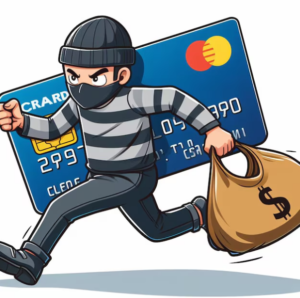How to protect your data from credit card fraud in the U.S.: Essential tips for security
Credit card fraud is a growing concern in the U.S., with cybercriminals constantly developing new tactics to steal financial information. If you don’t take proactive measures, your sensitive data could fall into the wrong hands, leading to unauthorized transactions and identity theft.
Fortunately, there are effective ways to safeguard your information and minimize the risk of fraud. From securing online transactions to recognizing phishing attempts, understanding these strategies will help you stay one step ahead of scammers.
Common methods used by fraudsters to steal your credit card data

Understanding how criminals operate is the first step in protecting your financial information. Fraudsters use various methods to obtain credit card details, and knowing their tactics can help you recognize threats before they impact you.
Phishing scams and social engineering attacks
Phishing scams remain one of the most common ways fraudsters steal credit card data. They often send emails or text messages that appear to be from legitimate banks, urging you to provide personal details.
These messages may contain links to fake websites designed to capture login credentials and credit card numbers. Always verify the sender’s email address and never click on suspicious links.
Social engineering attacks exploit human psychology, tricking victims into revealing sensitive data. Scammers may pose as customer service representatives and request verification details. If you receive an unexpected call, hang up and contact the institution directly.
Card skimming and ATM fraud
Card skimming is a technique where criminals install devices on ATMs or payment terminals to capture credit card information. These devices can be nearly invisible, making them difficult to detect.
To avoid skimming, always inspect card readers before inserting your card. If anything looks unusual or loose, use a different machine. Cover the keypad when entering your PIN to prevent hidden cameras from recording your keystrokes.
Another form of ATM fraud involves overlay keypads that record PIN entries. Using contactless payments or mobile wallets can help reduce your exposure to such risks.
Data breaches and dark web threats
Large-scale data breaches expose millions of credit card details every year, making them accessible to cybercriminals on the dark web. Even if you’ve never shared your information recklessly, your data may still be at risk.
Monitor your accounts regularly for unauthorized transactions and set up alerts for suspicious activity. Using virtual card numbers for online purchases adds an extra layer of security.
Cybercriminals often sell stolen data in bulk, increasing the likelihood that your card information could be misused. Changing your passwords frequently and enabling multi-factor authentication can help mitigate risks.
Best practices to protect your credit card information
Preventing fraud requires a combination of digital security measures and careful financial habits. By implementing the right precautions, you can significantly reduce the chances of falling victim to credit card scams.
Strengthening your online security
Using strong, unique passwords for each financial account is essential. Password managers can generate and store complex passwords, reducing the risk of unauthorized access.
Enable two-factor authentication (2FA) whenever possible. This adds an extra security layer by requiring a secondary verification method, such as a text message or authentication app.
Be cautious when shopping online. Only enter your credit card details on secure websites with “HTTPS” in the URL and a padlock symbol in the address bar. Avoid saving payment details on multiple sites.
Monitoring your transactions regularly
Frequently reviewing your credit card statements helps detect fraudulent transactions early. Many banks and credit card issuers offer real-time alerts for unusual spending activity.
If you notice an unauthorized charge, report it immediately. Most financial institutions have fraud protection policies that allow you to dispute transactions and recover lost funds.
Consider using virtual credit cards for online purchases. These disposable card numbers add an extra layer of protection by preventing merchants from storing your real card details.
Avoiding public Wi-Fi for financial transactions
Public Wi-Fi networks are often unsecured, making it easy for hackers to intercept data. Avoid entering credit card details while connected to public hotspots in cafes, airports, or hotels.
If you must use public Wi-Fi, enable a Virtual Private Network (VPN) to encrypt your connection. A VPN adds a protective shield that prevents cybercriminals from accessing your financial data.
When possible, use your mobile network instead of public Wi-Fi. Cellular data connections offer more security, reducing the risk of unauthorized access to your personal information.
What to do if your credit card data is compromised
Even with the best precautions, fraud can still occur. Acting quickly can minimize damage and help you recover stolen funds efficiently. Taking immediate steps can also prevent further unauthorized access to your accounts, limiting the overall impact.
Reporting unauthorized transactions immediately
As soon as you detect fraudulent activity, contact your credit card issuer. Most companies have dedicated fraud departments that can freeze your card and issue a replacement.
Dispute unauthorized charges promptly. Under U.S. law, consumers have limited liability for fraudulent transactions if they report them in a timely manner. The sooner you act, the higher the chance of recovering lost funds without long-term financial consequences.
Updating your account credentials, including passwords and security questions, can prevent further unauthorized access. Be sure to review other linked accounts for potential breaches.
Placing a fraud alert on your credit report
If you suspect identity theft, placing a fraud alert on your credit report can help prevent further misuse of your information. This notifies lenders to take extra precautions when verifying credit applications in your name.
You can request a fraud alert from credit bureaus such as Equifax, Experian, or TransUnion. A credit freeze is another option that blocks new credit applications entirely, providing additional protection.
Monitoring your credit score regularly can also reveal signs of identity theft. Unexpected drops in your score may indicate fraudulent activity on your accounts. Reviewing your credit report frequently can help you spot discrepancies and take corrective action before the damage worsens.
Enhancing your long-term security measures
To avoid future fraud, periodically review your financial accounts and update your security settings. Consider enrolling in identity theft protection services that monitor suspicious activity.
Regularly updating software on your devices helps close security vulnerabilities. Cybercriminals often exploit outdated systems to gain access to personal data. Keeping your operating system, antivirus software, and apps up to date ensures you’re protected against the latest threats.
Educating yourself and your family about online security can reduce the risk of future fraud attempts. Awareness is one of the most effective tools against cybercrime.
Graduated and master's student in History. Fanatic of books and series. Editor since 2023.




